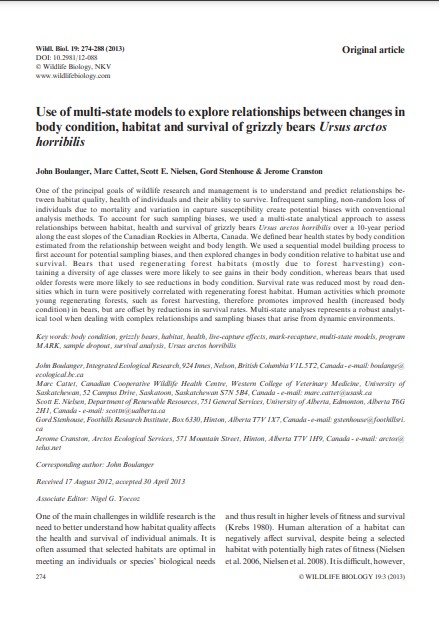Use of multi-state models to explore relationships between changes in body condition, habitat and survival of grizzly bears Ursus arctos horribilis
Bosque Modelo:
Foothills
Temática:
Conservación
Tipo de documento:
Artículo científico
Resumen
One of the principal goals of wildlife research and management is to understand and predict relationships between habitat quality, health of individuals and their ability to survive. Infrequent sampling, non-random loss of individuals due to mortality and variation in capture susceptibility create potential biases with conventional analysis methods. To account for such sampling biases, we used a multi-state analytical approach to assess relationships between habitat, health and survival of grizzly bears Ursus arctos horribilis over a 10-year period along the east slopes of the Canadian Rockies in Alberta, Canada. We defined bear health states by body condition estimated from the relationship between weight and body length. We used a sequential model building process to first account for potential sampling biases, and then explored changes in body condition relative to habitat use and survival. Bears that used regenerating forest habitats (mostly due to forest harvesting) containing a diversity of age classes were more likely to see gains in their body condition, whereas bears that used older forests were more likely to see reductions in body condition. Survival rate was reduced most by road densities which in turn were positively correlated with regenerating forest habitat. Human activities which promote young regenerating forests, such as forest harvesting, therefore promotes improved health (increased body condition) in bears, but are offset by reductions in survival rates. Multi-state analyses represents a robust analytical tool when dealing with complex relationships and sampling biases that arise from dynamic environments.
Información Bibliográfica
Autor:
Boulanger, J., Cattet, M., Nielsen, S.E., Stenhouse, G., Cranston, J.
Revista:
Wildlife Biology
Año:
2013
N°:
-
País :
Canadá
Páginas:
274 - 288
Volumen:
19
Idioma:
Ingles
Palabras claves
body condition, grizzly bears, habitat, health, live-capture effects, mark-recapture, multi-state models, program MARK, sample dropout, survival analysis, Ursus arctos horribilis





